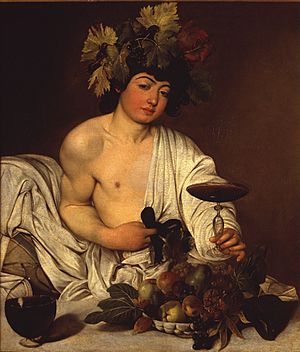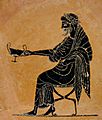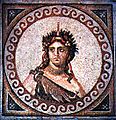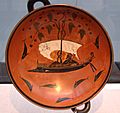Bacchus facts for kids

Bacchus was an important Roman god. He was known as the god of farming and wine. The Romans copied him from the Greek god Dionysus. Bacchus was the last god to join the twelve Olympians. The goddess Hestia gave up her spot for him.
His special plants were grapevines and twisting ivy. He often carried a staff with a pinecone on top. His followers included Satyrs, who had goat feet, and Maenads, who were women known for their lively dances during his festivals.
Contents
Who was Bacchus?
Bacchus was the Roman god of wine, grapes, and celebration. He also looked after farming and fertility. People believed he brought joy and excitement. His festivals were full of music and dancing.
Birth and Early Life
Bacchus had an unusual birth story. His father was Jupiter, the king of the gods. His mother was Semele, a human woman. Jupiter's wife, Juno, was very jealous. She tricked Semele into asking to see Jupiter in his true god form.
Because Semele was human, she could not survive seeing Jupiter's full power. She was burned up by the sight. But Jupiter saved their unborn child. He sewed the baby Bacchus into his own thigh. Nine months later, Jupiter gave birth to Bacchus.
As a child, Bacchus was taught by Silenus. Silenus was a wise old friend of the gods. Before Bacchus joined the gods on Mount Olympus, he traveled widely. He went as far as India. During his travels, he taught people how to grow grapevines. He also showed them how to make wine.
Bacchus's Symbols and Followers
Bacchus is often shown with grapevines and ivy. These plants were sacred to him. He carried a special staff called a thyrsus. This staff was topped with a pinecone.
His followers were a lively group. The Satyrs were mythical creatures. They had human bodies but goat legs and horns. The Maenads were women who worshipped Bacchus. They danced with great energy during his special events. These celebrations were known as Dionysian Mysteries. They were times of great joy and freedom.
Related Gods and Myths
Bacchus is very similar to the Greek god Dionysus. They share many stories and characteristics. Both gods represent the wilder side of nature. They are also linked to creativity and drama. Many myths about Dionysus are also told about Bacchus.
Images for kids
-
Dionysus extending a drinking cup (kantharos) (late sixth century BC)
-
A Roman fresco depicting Bacchus with red hair, Boscoreale, c. 30 BC
-
The Conquest of India by Dionysus at the archaeological museum of Sétif, ca. 200–300 CE
-
Roman marble relief (first century AD) from Naukratis showing the Greek god Dionysus, snake-bodied and wearing an Egyptian crown.
-
Painted wood panel depicting Serapis, who was considered the same god as Osiris, Hades, and Dionysus in Late Antiquity. Second century AD.
-
Bronze hand used in the worship of Sabazios (British Museum). Roman first–second century AD. Hands decorated with religious symbols were designed to stand in sanctuaries or, like this one, were attached to poles for processional use.
-
Birth of Dionysus, on a small sarcophagus that may have been made for a child (Walters Art Museum)
-
Marble bust of youthful Dionysus. Knossos, second century AD. Archaeology museum of Heraklion.
-
Wall protome of a bearded Dionysus. Boeotia, early fourth century BC.
-
The Infant Bacchus, painting (c. 1505–1510) by Giovanni Bellini
-
Badakshan patera, "Triumph of Bacchus" (first–fourth century). British Museum.
-
North African Roman mosaic: Panther-Dionysus scatters the pirates, who are changed to dolphins, except for Acoetes, the helmsman; second century AD (Bardo National Museum)
-
The Triumph of Bacchus, Diego Velázquez, c. 1629
-
Hanging with Dionysian Figures from Antinoöpolis, fifth–seventh century (Metropolitan Museum of Art)
-
Bacchus - Simeon Solomon (1867)
-
The Dionysus Cup, a sixth-century BC kylix with Dionysus sailing with the pirates he transformed to dolphins
-
Bronze head of Dionysus (50 BC – 50 AD) in the British Museum
-
Statue of Dionysus in Remich Luxembourg
-
Terracotta vase in the shape of Dionysus' head (circa 410 BC) – on display in the Ancient Agora Museum in Athens, housed in the Stoa of Attalus
-
Amphora with cult mask of Dionysus, by the Antimenes Painter, around 520 BC, Altes Museum
-
Cult mask of Dionysus from Boeotia, fourth century BC
-
Marble statuette of Dionysos, early third century B.C, Metropolitan Museum
See also
 In Spanish: Dioniso para niños
In Spanish: Dioniso para niños








































